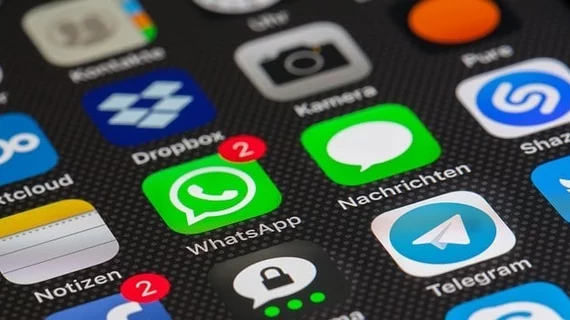Radiologists gather COVID-19 second opinions from far-flung peers using WhatsApp
The COVID-19 pandemic has the potential to overwhelm busy provider organizations, especially those that are short on CT scanners or thoracic radiologists. But social media could provide relief, according to one preliminary study.
Such shortages are particularly acute in Iran, which has logged more than 29,000 coronavirus cases as of Thursday and 2,200-plus deaths. It’s one of the hardest hit countries in the world and yet radiologists there have grappled with inadequate resources. Those include few onsite lung specialists and just 6.5 CT scanners per 1 million individuals, researchers reported Tuesday in the Journal of the American College of Radiology.
Aiming to address this shortfall, Iranian imaging physicians helped to create a smartphone-based solution using the social media program WhatsApp. They’ve found early success, uploading more than 1,100 CT studies to the platform for assistance, with reports generated in less than two hours in 100% of cases.
“Our humanitarian teleconsultation strategy allows [for] reliable triage of COVID-19 infection using radiology experts from centers from around the world to provide consultation in regions with limited access to thoracic radiology expertise during a rapidly growing epidemic,” wrote lead author Amir Davarpanah, MD, a professor at Emory University, and coauthors with the Iranian Society of Radiology. “This highlights the important role of radiologists during a global health crisis.”
The society first launched the effort in February, inviting rads from across the globe to take part in its “second opinion teleradiology group.” Eleven thoracic imaging specialists heeded the call, including nine in Iran, and one apiece in Canada and the U.S.
Iranian experts pinpointed patients with early lab and clinical findings for COVID-19 and gathered CT scans with interpretation by local radiologists. Those with abnormalities were then referred to the social media group for further interpretation. The society also encouraged radiologists across Iran to do the same.
Referrers first submitted CT images to a volunteer network coordinator through WhatsApp, in JPEG or MP4 format. This physician facilitator then assigned a case number and posted images to the private Iranian Society of Radiology COVID-19 Consultants group. One of the 11 volunteers responded by generating a report as a comment in the social media app, using their password-protected smartphones.
“Disagreements on specific cases were resolved by consensus agreement through radiologists’ discussions in the same post,” Davarpanah and colleagues wrote. “Participation of expert radiologists in different time zones allowed efficient time coverage for reviewing submitted images.”
The coordinator subsequently shipped the final report to the original referrer using WhatsApp or email, typically in the same format. DICOM was used in cases with suboptimal image quality— about 19% of the time. Other key details—such as age, chief complaint, vital signs, lab results and course of care—were also included.
All told, radiologists across 65 cities uploaded CT exams from 1,138 patients in less than a month. Almost 43% displayed patterns suggesting viral pneumonia, with docs referring them for further lab testing and potential isolation. Another 41% had imaging inconsistent with viral pneumonia and were referred for management of alternative diagnoses.
Despite any limitations—including concerns about patient privacy, and overlap of CT findings between COVID-19 and other pneumonia— Davarpanah and colleagues believe their experiment could prove useful elsewhere. The JACR research was printed as a pre-proof study to provide early access to healthcare professionals.

